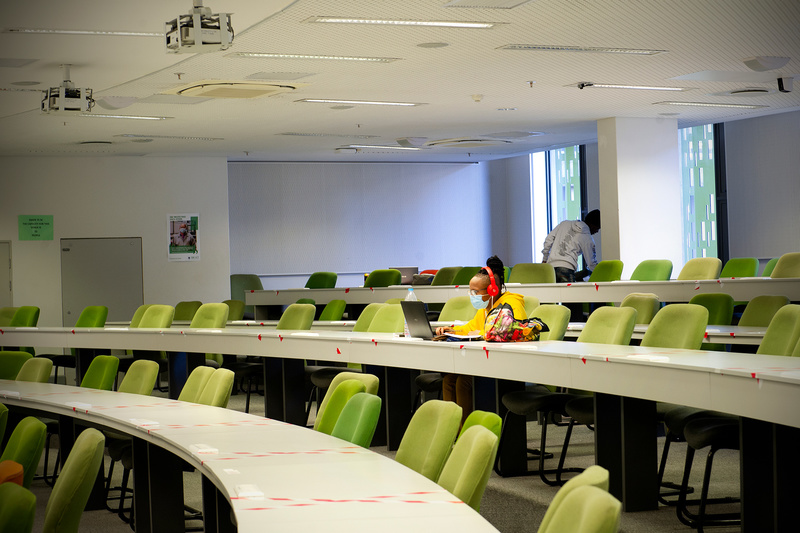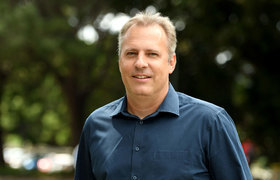UCT’s carbon footprint report shows marked COVID-19 lockdown reductions
30 November 2022 | Story Helen Swingler. Photo Lerato Maduna. Read time 6 min.
The University of Cape Town’s (UCT) recently launched Carbon Footprint Assessment Report for 2020 and 2021 reflects the direct impact of the COVID-19 lockdowns on its carbon emissions. An “unprecedented time in UCT’s history”, the pandemic reduced campus activity and saw carbon emissions decline sharply to below those of 2012, when consistent reporting began.
Awareness of the link between climate change and carbon emissions has been heightened in the wake of COP27, the 27th United Nations Climate Change conference in Sharm El Sheikh, Egypt. Since then, the call for reduced emissions has been loud.
Monitoring and reporting on carbon emissions is critical to UCT’s sustainability drive, said Manfred Braune, the director of environmental sustainability in the Office of the Vice-Chancellor, and leader of the report project team. It details the emissions-generating activities of UCT’s 35 700-strong community across all six campuses.
Rising and falling with COVID-19 lockdowns
The assessment is undertaken applying the International Greenhouse Gas Protocol, the most widely recognised global methodology for greenhouse gas accounting and reporting, said Braune.
Three scopes of direct and indirect emissions were conducted and show that total emissions dropped 30% between 2019 and 2020, when COVID-19 restrictions were at their most stringent. But this was followed by a 25% increase in 2021, the result of “partially stabilised activities” on its campuses.
“Reduced emissions from air travel contributed significantly to the initial decrease.”
Scope 1 considered the combined direct emissions from all UCT’s operationally controlled activities, such as the shuttle and vehicle fleet, travel, diesel and liquid petroleum gas combustion and refrigeration top-ups. Scope 2 examined indirect emissions from bought electricity. Scope 3 considered other indirect emissions.
However, UCT’s emissions profile reflected that of previous years. Indirect emissions linked to purchased electricity contributed the most to the overall footprint, accounting for about two-thirds of total emissions per year.
Travel, diesel and electricity
UCT’s combined direct emissions showed a decline of 54% between 2019 and 2020 as almost all UCT activities slowed during lockdown.
“Reduced emissions from air travel contributed significantly to the initial decrease,” added Braune. “These dropped 94% from 2019 because of COVID-19 restrictions and lockdown.”
The exception was diesel-generator emissions, which rose by a whopping 245% in 2020 because of growing loadshedding. Diesel-generated emissions rose a further 26% in 2021, even though these are a small portion of the overall carbon footprint.
Emissions from bought electricity followed a similar trend, dropping 28% in 2020 and rising by 17% in 2021. This emissions source contributed a significant 64% of UCT’s total carbon footprint in 2021. Of this, electricity used on main campus contributed 54%. The next largest consumers were the Health Sciences campus and satellite residences.
“Seeing that emissions from electricity did not drop as significantly as expected during lockdown implies that there are a lot of inefficiencies in how the university uses electricity.”
“Although emissions from bought electricity represents a carbon management challenge, it also provides the biggest opportunity for UCT to implement reduction initiatives that will significantly impact our overall carbon footprint,” said Braune.
“Seeing that emissions from electricity did not drop as significantly as expected during lockdown implies that there are a lot of inefficiencies in how the university uses electricity while mostly unoccupied, although there are many research operations, laboratories, cold rooms and other specialised pieces of equipment that cannot be switched off and have to continue operating during such restrictions.”
Emissions from construction and travel
While UCT has been tracking carbon emissions since 2012, this report is the first to consider construction-associated emissions, mainly embedded greenhouse gases in building materials, forming part of Scope 3 emissions.
This assessment reveals the significant proportion that construction-associated emissions form within the Scope 3 emissions, in this case almost a third of Scope 3 emissions.
While we saw the addition of emissions related to construction materials, UCT also saw a dramatic reduction in emissions from air travel and car hire during these restricted times. A lot was learnt during this time, where staff will feel that some of these meeting can happen online rather than needing to get on an aeroplane to travel for a meeting.
Spruce up data and carbon management
What comes next? Braune points to two areas where UCT can brush up: data management and high-priority carbon emissions reductions.
Improved data quality will improve the accuracy of emissions results and the calculation of greenhouse gas emissions. A lot of work will need to go into ongoing improvement of data collection and management thereof, hosted by various departments.
In terms of carbon emissions reduction strategies, the report recommends that these focus on the highest emissions sources that UCT can control, such as the electricity consumption on main campus.
Future emissions inventories will also consider “avoided emissions”; this is where renewable energy is being used, photovoltaic installations that are being rolled out on campuses.
“If UCT continues on its transition from grid to renewable energy and continues to install energy-efficiency initiatives for lighting and air conditioning, these ‘avoided emissions’ will begin to mitigate those from bought electricity over time,” said Braune.
 This work is licensed under a Creative Commons Attribution-NoDerivatives 4.0 International License.
This work is licensed under a Creative Commons Attribution-NoDerivatives 4.0 International License.
Please view the republishing articles page for more information.
Related










